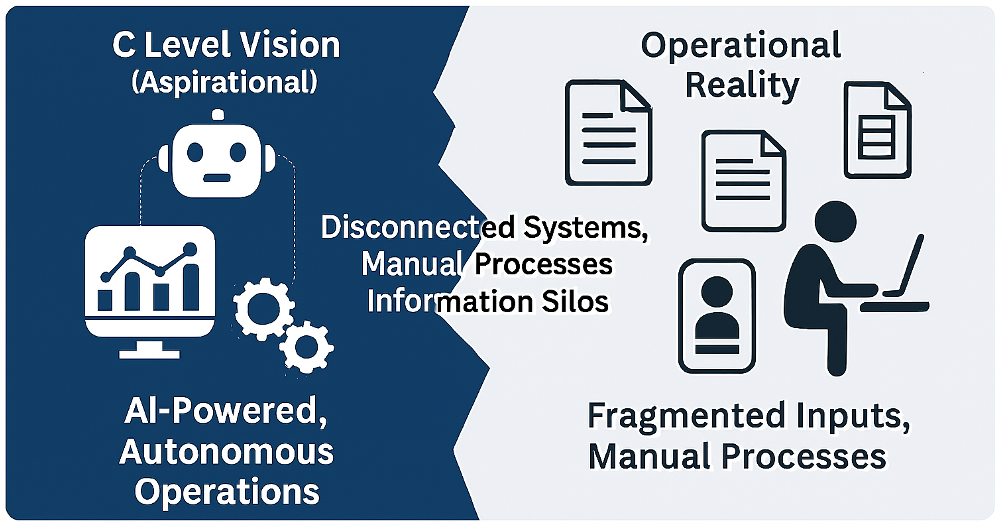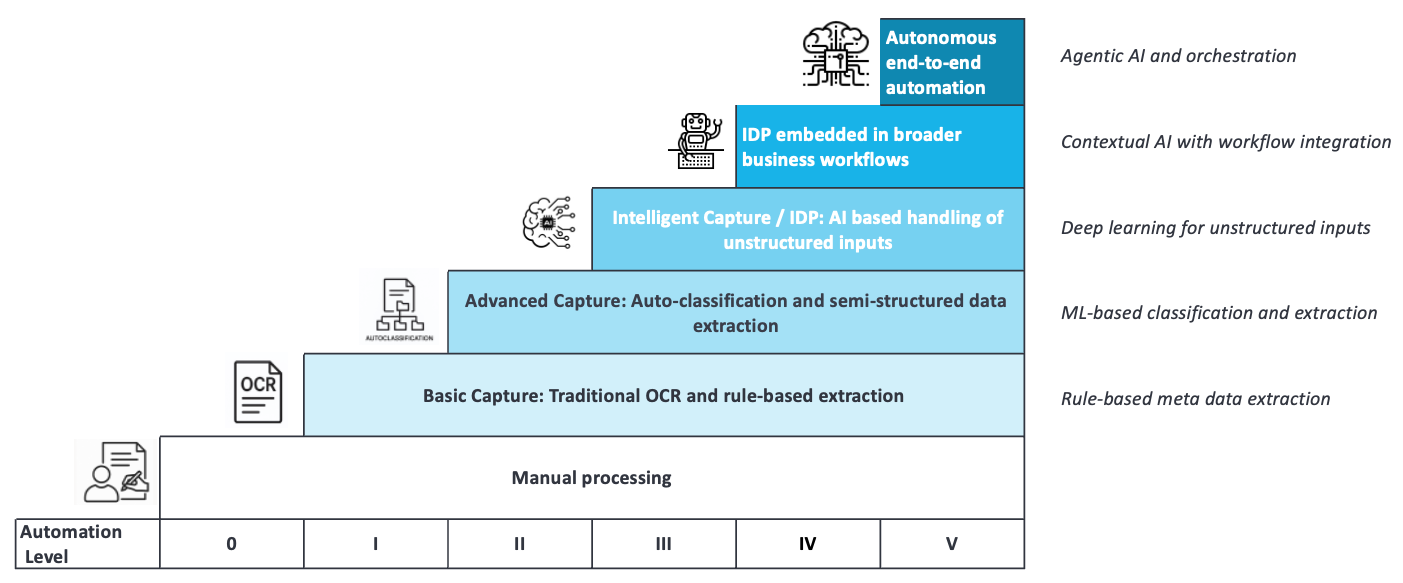By Petra Beck, Senior Analyst, Software Practice at Infosource
Executives are pressing for agentic AI at scale, while operations still wrestle with manual inputs, fragmented channels, and inconsistent automation; this blog post highlights the presentation
given at the 2025 ARMA InfoCon conference. This article summarises the main insights from the session and outlines practical steps organisations can take to align executive AI strategies with operational implementation.
Problem at hand
C‑suite interest in GenAI and agentic AI is surging, with leaders expecting revenue growth and efficiency gains, yet very few organisations describe their rollouts as mature. On the ground, rising volumes and diverse inputs across paper, email attachments, fax, and text channels flow through isolated processes with varying automation, leading to silos, rework, and compliance exposure.
the ai ambition gap

DEFINITIONS THAT MATTER
Intelligent Document Processing: Software that classifies and extracts accurate, usable data from unstructured and semi‑structured inputs for transactions, analytics, records, discovery, and compliance.
Agentic Automation: Software agents that perceive, reason, and act with minimal human input, adapting to context beyond static rules and extending automation from IDP to downstream processes.

How to bridge the gap
- Identify high‑impact candidates for automation based on the operational reality: Map the process ecosystem to identify and prioritise candidates considering process inefficiencies and error rates, automation potential and the opportunity for quick wins.
- Assess C-level strategic goals and GenAI expectations and translate them into an actionable vision.
- Build a roadmap to reach strategic goals by implementing automation plans: run phased pilots, measure relentlessly, adapt designs, and scale proven patterns with clear sponsorship and communications.
Current state assessment: Selecting the right processes
At the ecosystem level, identify and prioritise automation opportunities considering mission criticality, interdependencies, risk/compliance exposure, and improvement potential. Conduct a detailed assessment of the shortlist of candidates using criteria such as volume/frequency, level of automation, expected impact on time, cost, Customer Experience (CX), and risk to reveal bottlenecks and quick wins.
Establishing an actionable vision
Executive expectations are based on their strategic goals including top-line and bottom-line growth, competitive differentiation, and customer experience improvements with the expectation that GenAI and Agentic AI will offer material improvements.
Only a minority of organisations have integrated AI agents into broader workflows, despite AI ranking as a top‑three strategic priority among executives in current surveys. Many leaders also report their companies are developing GenAI tools too slowly, underscoring the urgency for pragmatic roadmaps that deliver visible progress.
Roadmap: pilot to scale
Bridging the automation gap requires phased pilots, iterative learning, and a commitment to scale what works across the business supported by clear sponsorship. Success requires transparency and regular communication that keeps leadership and operations aligned on progress, risks, and decisions.

Avoiding pitfalls
- Overpromising benefits: set clear scope and stage value delivery, anchoring expectations in pilot metrics and realistic ranges.
- Poor change management: build structured enablement and maintain proactive, tailored communication with champions and accessible guidance.
- Underestimating data/integration: run data quality and integration sprints, clarify ownership, map interfaces, and rehearse in lower‑risk environments.
- Vision-execution disconnect: hold biweekly exec–ops reviews and keep a transparent decision log to accelerate resolution and learning.
Important aspects to consider
AI/GenAI is considered a major transformational force in current C‑suite surveys, but enterprise understanding of GenAI’s value remains moderate, especially outside leadership ranks. Leadership support and employee expertise materially influence attitudes toward GenAI and understanding of AI agents, affecting adoption and outcomes.
Practical calls to action
The presentation included a series of recommended actions for the attendees to establish an actional plan for bridging the gap.
- This week: write down one process where the AI ambition gap is most visible and tag it as a candidate for improvement.
- Within two weeks: map a candidate process end‑to‑end, including inputs, handoffs, delays, and error hotspots, using a swimlane
- Next quarter: launch at least one pilot focused on a “quick win” from the shortlist, with KPIs defined to gain important learning.
- This month: review two past automation efforts, capture three lessons each, and feed them into the pilot design and risk log.
- Ongoing: establish monthly exec–ops reviews to ensure transparency about project progress and remove potential blockers.
Key takeaways
Real transformation bridges vision and execution—start practical, measure relentlessly, and scale with purpose to convert AI ambition into durable outcomes. Envision the future grounded in the present, start small to win early, and scale what works with governance and continuous exec–ops alignment.
Organisations that turn AI strategies into measured, pilot‑driven action will accelerate maturity and build the resilience needed to sustain automation at scale.